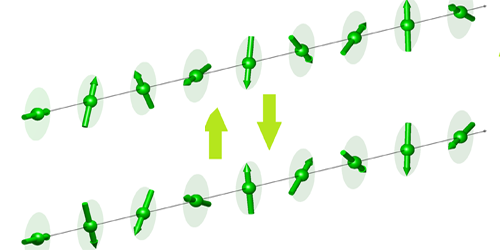Chiral Magnetism Under Electric Control
Magnetic ordering usually involves a parallel or antiparallel alignment of spins, but in some cases it is characterized by a spiraling pattern. This so-called chiral magnetism might one day prove useful for high-density data storage. Researchers have now demonstrated that electric fields can switch the magnetic chirality of multiferroics—materials that are both ferroelectric and magnetic. The experiments were performed at temperatures in which long-range correlations in the magnetic ordering were absent. This implies that chiral magnetism could be controlled within small domains that could store a single bit of information.
Multiferroics exhibit long-range chiral magnetic ordering when cooled below a critical temperature. Recent work has shown that applying an external electric field while cooling below this critical temperature can fix the orientation (clockwise vs counterclockwise) of the magnetic chirality. This electric control, however, works only on large, fully ordered samples and not on small domains that would allow dense packing of data.
To explore electric control without long-range order, Jonas Stein from the University of Cologne, Germany, and his colleagues performed polarized neutron scattering on two multiferroics: and . By measuring the flipping of the spins of neutrons scattered by the samples, the researchers extracted information about the magnetic ordering in the material. They found that an applied electric field could locally induce chiral magnetism even when the temperature was above the critical temperature, that is, when the sample was too warm for the long-range order to be frozen in. This suggests that electric control could work on small, individual domains, without requiring long-range ordering. Besides showing the potential for data storage, the experiments also highlight the role of excitations, called electromagnons, in establishing long-range order in multiferroics.
This research is published in Physical Review Letters.
–Michael Schirber
Michael Schirber is a Corresponding Editor for Physics based in Lyon, France.





